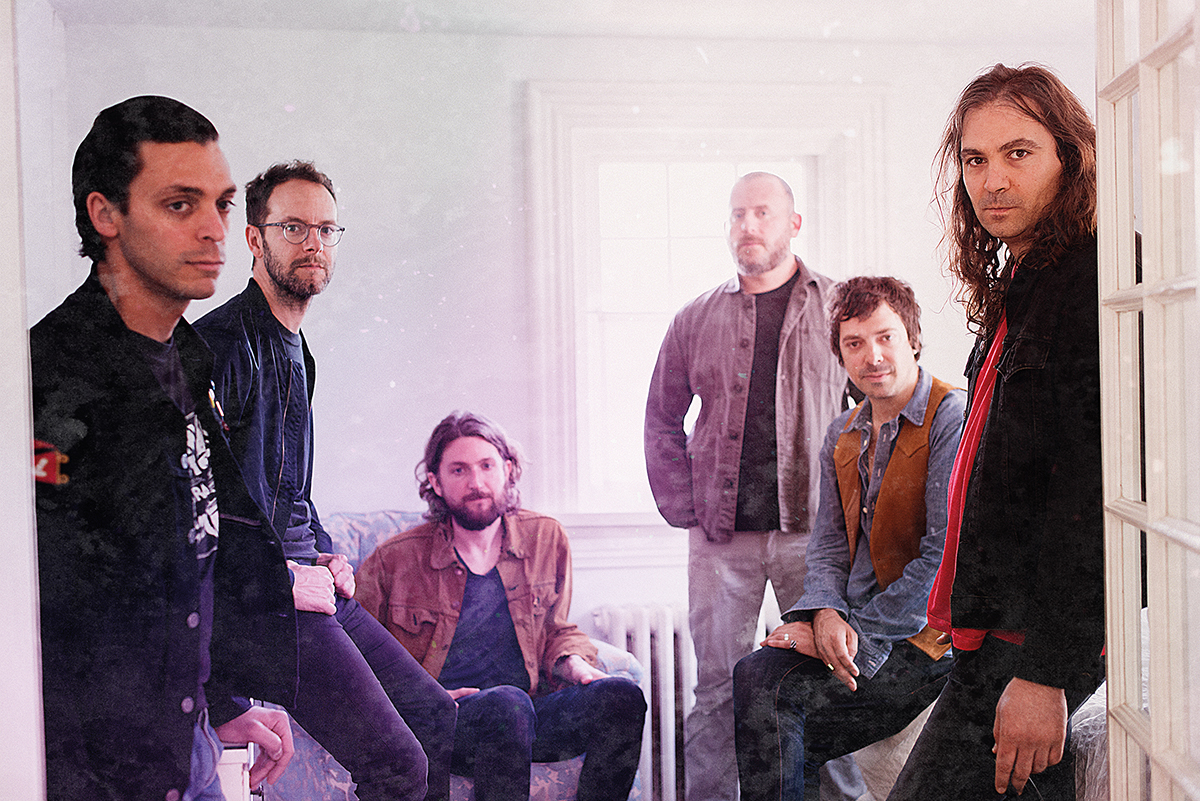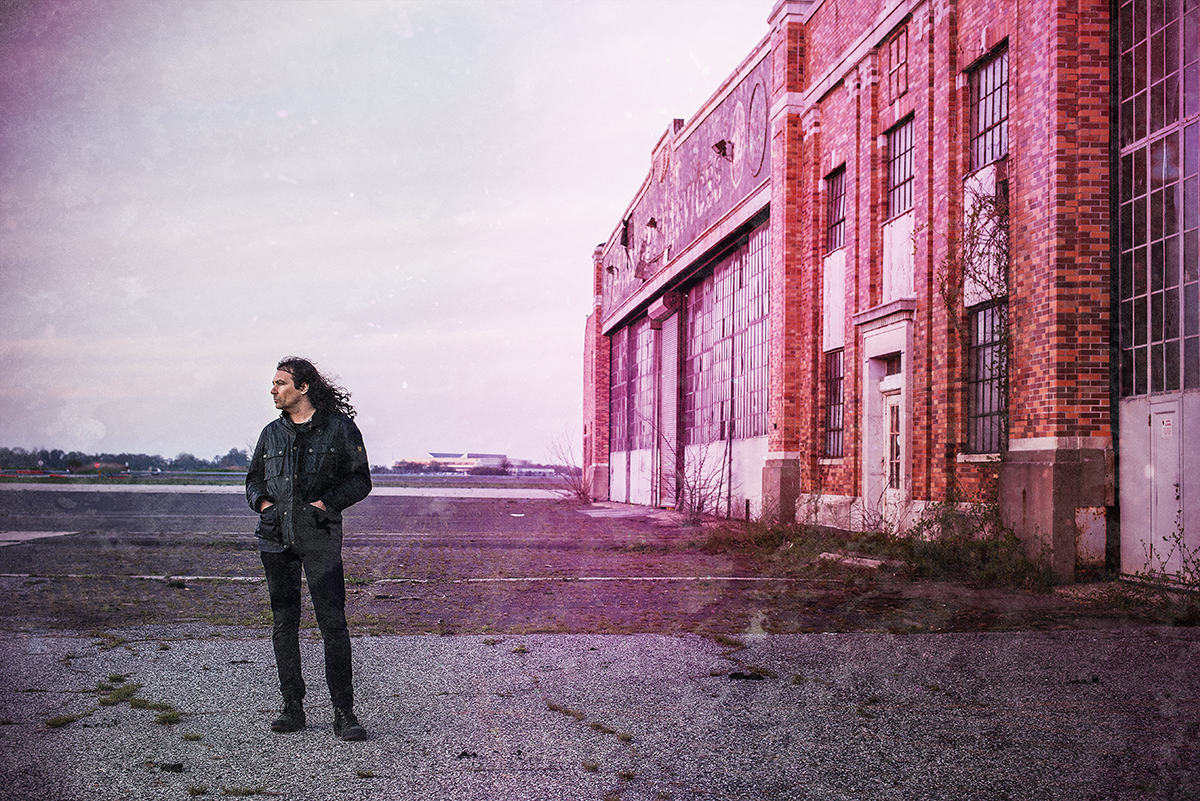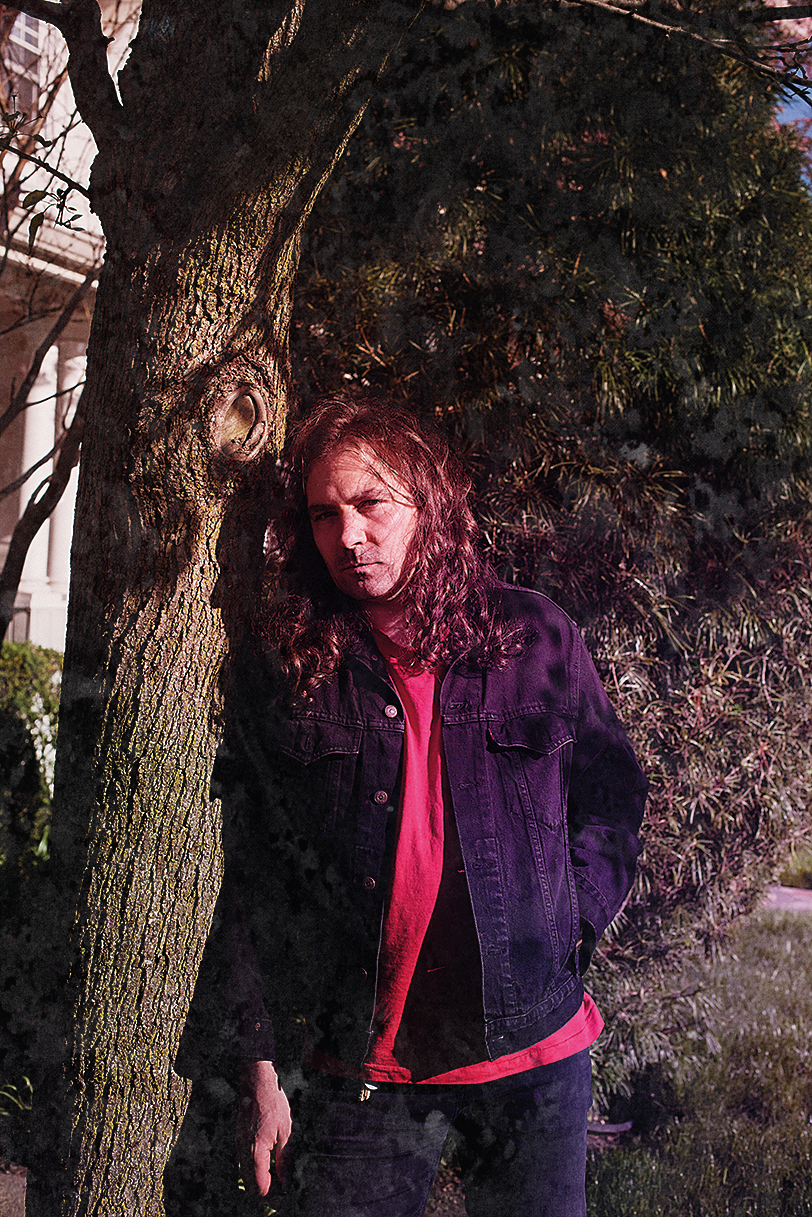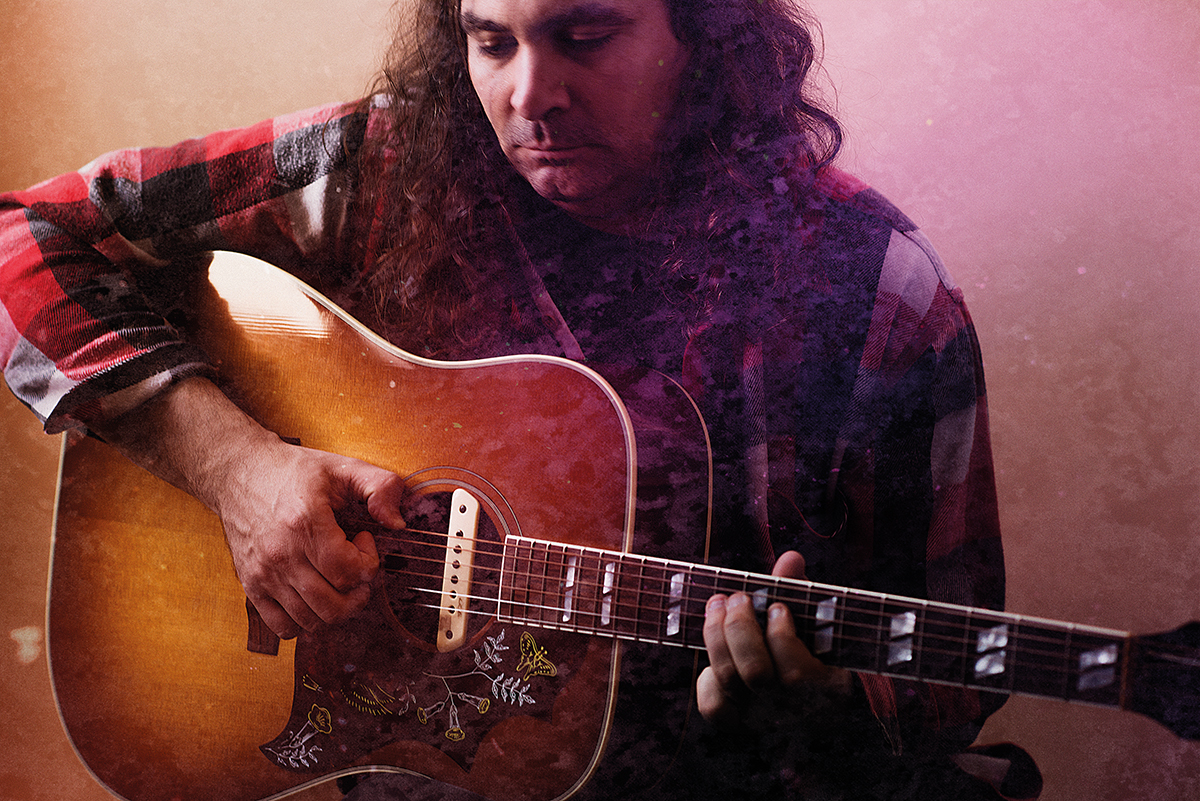Interview: The War On Drugs – War Correspondent
Three years after breaking into the indie mainstream with Lost In The Dream, the spacey Philadelphian sextet return with their best record yet, A Deeper Understanding. Ahead of its release, we sat down with creative fulcrum Adam Granduciel to talk phasers, Falcons, and the joy of 1980s multi-effects…

The first time that Adam Granduciel – frontman, guitarist and heartbeat of The War On Drugs – picked up an electric guitar, he knew things would never be the same again – “It was like that moment,” the 37-year-old Bostonian explains as he reclines on a sofa in the Warner Music offices in London. “It was seventh grade, I’d got super in to music six months before, so I was obsessed.
I went over to my friend Jeff’s house – he played drums because his dad played guitar. In retrospect, he obviously had his son learn drums so he had someone to jam with! He had what would now be considered a man cave in the basement with a pool table, his son’s drum kit, a four-track… and he had a red Washburn, a Peavey amp and an ART digital effects system.”
The 12-year-old Granduciel had caught the grunge bug when he first heard Nirvana’s In Utero, but nothing could prepare him for the experience of picking up that red Washburn…
“I plugged in the guitar – and it was like, unlike anything I’d ever…” Adam trails off, struggling to find the words. “I could feel the floor shake. It was just the standard tone, but in 1992 that was like, distortion with chorus and phaser on it [chuckles] – if you wanted a ‘normal’ sound on a guitar, that’s where you would start! Every multi-effects unit, that was preset 001 – like, an insane amount of chorus!
But the greatest feeling I’d ever experienced was playing that guitar, and I just knew from that moment that was what I wanted to do. I don’t think my parents bought me a guitar for maybe a year, but I would just be like, ‘I can’t wait until I can go and see Jeff and play that guitar again’. The next time I went over I learned a chord, E minor, and then A… and I made 20 songs out of those two chords!”
Modulation Station
Listening to The War On Drugs’ music, it’s clear that while Granduciel’s grasp of the electric guitar has come a very long way from two-chord endeavours, the none-more-80s sound of that original multi-effects preset left its mark. Listen to 2014’s breakthrough record, Lost In The Dream, or their brand new major label debut, A Deeper Understanding, and you’ll hear spades of chiming chorus, pulsating phasers, soaring delays and a veritable cathedral of reverb over every song.
These effects may have earned a bad name for themselves in the 1980s, but A Deeper Understanding reaffirms how, in the right hands, they can create dazzling ethereal soundscapes that form the multi-layered bedrock upon which The War On Drugs’ soaring anthemic rock songs are built.
It’s no surprise that Adam has ended up approaching these tools with a more grounded, more visceral take when you consider his guitar influences. Nirvana, Soundgarden and Smashing Pumpkins are perhaps to be expected, but king among his inspirations is arch-retronaut, Neil Young.
“Around that time he was doing all that stuff with Pearl Jam, so it was like ‘Oh yeah this Neil Young guy…’” he explains. “Because I had Harvest and Harvest Moon, but I didn’t know he was also a guitar guy – so then I got into him and went down that road.”
Since the departure of his friend Kurt Vile in 2008, The War On Drugs has very much been Granduciel’s project, with a revolving cast of musicians coming in to work with him at his Philadelphia base. However, the success of Lost In A Dream led to a long world tour that would throw Adam and the core band into a more traditional dynamic.
“I would be nowhere without the guys I play in the band with, and they know that,” he explains. “We also really respect that this is what has worked, yknow? I have a certain way of working. But as you do more and more touring, everyone becomes way more involved in making it their own thing.”
The tour also gave Adam and the rest of the band a chance to develop songs together at sound-checks, allowing them to have more direct input on the way songs developed. “It’s the only time that you get to have band practice every day for two hours. There’s nowhere anyone needs to be!” Adam chuckles. “We’re a thousand miles from home – no-one’s got to run out. So it’s really the best time to write and get ideas going.”
Going It Alone
It turned out that the prep was useful – after the band returned from tour, Adam opted to move out to Los Angeles to work on the album, leaving him several thousand miles from his band – and everyone in his life.
“I was a little bit more physically isolated, rather than just emotionally.” he reflects. “I couldn’t call up my buddies and go have a beer, or I couldn’t go hang out on the weekends or involve myself in their lives in the way that I want to. And then musically, I couldn’t have them over to the studio that night – we had to find a time that worked and then I had to fly everyone out, and get them an Airbnb.
And then it was like, super focussed, seven days of music. It wasn’t a lot of, ‘Let’s go hang out!’ Because I knew I only had ‘em for a week and I wanted to squeeze everything into that week – rehearsal, writing, friendship, barbecues… so we did it all at the studio – we barbecued at the studio!”
With such a limited time-frame, the soundcheck jams and some abortive recording in studios on the East Coast paid dividends when they went in to the studio in LA with producer Shawn Everrett.
“People were more familiar with the songs by the time we started recording them, because we’d demo’d a bunch of stuff, and stuff had been played or conceived on the road – or I had written a song and we played it at sound-checks,” Adam explains. “And we’d tried to record a bunch of different times and nothing had really happened, y’know?
So people were like, ‘Oh we’ve recorded this – what isn’t working? Why doesn’t Adam like it? What can I do different on this session?’. It was pretty collaborative – and some of it was done the old way of piecemeal, or me taking bits and bobs from people – but it was more collaborative on the whole.”
Delving Deeper
Listening to the interesting and esoteric nature of Adam’s guitar parts, it’s perhaps understandable that when it comes to writing, guitar isn’t always his first port of call.
“Guitar is tough because you really have to imagine it,” he observes. “A guy in a hotel room with an acoustic guitar and some feelings… you’re like, ‘Yeah, I’ve heard this before!’ But flash forward a year and a half to the recorded version of that and it’s, ‘Oh I haven’t heard this before.’ But you have to go on something other than the basic chords and structure [to get that far] – you have to remember songs and think, ‘There’s something about this I like, I should come back to it with the band, or on an organ’.
I like writing on piano because it’s immediately sombre – my piano ability is pretty limited, but I like to think that I can develop a bit of a style within the chords that I know how to play.”
Given the dense, multi-layered nature of the sound, however, when the time comes to put these parts together, restraint is the order of the day – and it’s not always the easiest thing to do.
“That’s the thing – aways leaving some space,” Adam acknowledges. “But the problem is that I get so in to recording that I spend six, seven, eight months on the same song. And I have all these different melodies going on in the song, and you want to highlight each of them, so it’s trying to sculpt this thing where, if you put everything in, it would just be a wash, so you’re trying to paint this picture, but keep all your favourite elements in.”
Spending eight months on a song might seem excessive, but Adam’s self-reflective style allows him to hone in on exactly what a guitar part needs to be.
“A lot of it comes from demoing, and recording, and then listening to the demo over and over,” he notes. “It’s having time to listen to the demo and be like, ‘Oh that solo is actually almost there’. I feel like this record has more ‘composed’ guitar parts – solos that are actually ‘this note, then this note…’ – it’s more of a phrase than a bunch of wanking. It’s fun to have wanking and noodling… and then it’s also cool to make a progression to a record where we’re like, ‘In this section, it’s always going to be this’.”
Eclectic Guitar
As suits his eclectic guitar style, the guitars that Adam took into the studio are an equally diverse mix. “I used my Les Paul, which is a ’72 Deluxe. I’ve got a 1980s Japanese Squier Strat that I used a lot on the record – it’s just easy to play, light,” he explains. “I also used my Gretsch White Falcon a lot.
Towards the end of this record I bought this ’66 SG – I was sat playing it in the store and it was so sweet, I couldn’t not. I went back the next day – it was a refin so it was a little cheaper – and I bought that and then peppered that on a bunch of songs. I and have one of the new Fender Jazzmasters, the ’65 reissue. I really like that guitar.
“I also have a vintage non-reverse Firebird – I guess it was maybe a ’65 but it was refin’d and it had P-90s put in it – the only original thing about it is the body and the neck. But that’s a tough guitar – a tough one to put down and come back to. You really have to play it all the time, or just not play it at all. I don’t know what it is! I’ve also picked up other Firebirds that don’t feel like that one – it’s an interesting instrument! The first time I played it I was in love with it – it was the first nice guitar I ever bought.”
We notice that his tastes tend to lean towards vintage Gibsons and new Fender and Gretsch guitars, and his reasoning for that is typically pragmatic.
“Well, I buy the vintage Gibsons and they give me the new Fenders!” he laughs. “But it’s cool, it’s awesome. Fender have been awesome – they gave me that Gretsch, and the Jazzmaster, and I use the shit out of them. I want to buy a vintage Jazzmaster, but I’m also like, the way that the new one is, is like it’s its own kind of sound.
In the middle position – that Jazzmaster, with a chorus pedal – it’s like the brightest, most crystalline thing. I’ll put it this way, I wouldn’t play a 1961 Jazzmaster the way I treat this one. Because if it breaks, I don’t really care… well I do care, but it’s fixable. I really lay into it, and it sounds different to a vintage one, and that’s what’s kinda cool about it.”
Effects Appeal
When it comes to the all-important effects side of things, Adam leans on trusted boxes that he knows he can use and abuse in just the right way to create the musical, non-cliched sounds he’s searching for.
“I think just trying to keep it simple and not over-thinking it,” he affirms. “I really have one pedal for my chorus, which is my Memory Man on chorus mode – I’ve never been a Deluxe Memory Man kinda guy, I’m more about the Stereo Memory Man. I don’t want to AB a bunch of chorus pedals, y’know? I just know that’s the one that I really like. Phasers can be a slippery slope, but I have a couple of old ones that are cool – I had an old MuTron that doesn’t work any more, but the guy from MuTron just sent me one of his new phasers, and they’re actually really awesome.
You can go between four-stage and six-stage, so you can almost get a Leslie effect. I love researching gear, but I don’t want to use everything – I like to use the things where I know how they’re going to respond. Like for example, when I hit the gain pedal, it’s going to mess with the chorus pedal. I love Strymon, but sometimes if you just have only new things that aren’t made to get glitchy… when you have old things going into new things, shit can get fucked up in a cool way.”
In a live environment, however, the textures he needs to conjure give him a bit of a headache – after all, who doesn’t want more pedals?
“It’s a source of great stress to me!” he exclaims. “This last week my tech, my friend Dominic in New York, I said to him, ‘I have to go to Europe for two weeks, can you bring my pedalboard to Bob [Bradshaw], who’s the guy who designs the switching system, because he needs to give it a tune up before the tour’ – and I put a box together with Dom of 10 new pedals that I want to swap out.
But then last week we played a show and were rehearsing, and I got used to the board again the way I had it. So I really want to swap out these pedals, but it sounded sweet last week, and I don’t want to fuck around with it! So I have this spreadsheet going on that’s like ‘The New Order’. [laughs]”
“The main thing right now is that I really have just one delay, which is my HardWire delay – I love those. I just want that very easy digital delay – I don’t like timed tap tempos – I just want something to take the edge off it a little bit. I also use the HardWire reverb, just for reverse reverb. They’re really strong. I have my Memory Man as a chorus, I have a stereo Uni-Vibe thing, and then the main thing is just figuring out my gain staging, because I always want to go one louder – so now I have like four pedals that get me louder.
“My switching system is such that I hit a button and it brings that pedal into the loop, but what I found out the other day, which I’d never really realised, is that I can have more than one pedal in one loop – so I can have three tremolo pedals as options, but then I just have to manually turn them on instead of having them all on.
So, once I realised that, it was like, ‘Oh…’ So now I’m going to have to send it all to Bob – the master! But it’s super fun – I just go for what works and what’s reliable. The vintage stuff is cool, but sometimes in a live context and a touring context – either due to powering or durability, they can be problematic.”
“In the studio, when I don’t have to use my board, I can plug the guitar into the fuzz and right into the console, which is like my favourite thing – but you don’t do that live! Then I have my tape echo, too. But for the live ’board it’s a cool mix of utilitarian and some esoteric stuff. I have a LoveTone Doppleganger on there now – I’m not sure if I need it, but it’s awesome for one thing, so I’m like, ‘fuck it!’ – even though it takes up half the board. The Strymon stuff is cool – it’s really useful.
The Flint is probably my favourite of their pedals, because I used it on so many of the keyboards on the record – it has that tremolo that you can work with your hands. I have it on my board with just a little bit of reverb, and then if I want tremolo I can hit the tremolo side, and I’ve got that going. I love those new Moog pedals, the smaller ones – the Tremolo is really awesome. I love tremolos, that’s another one. I just got that [Fulltone] OCD overdrive, which is killer – it’s not fuzz, but it has bite, like one level of crunch for a solo. It’s really sweet.”
Leading Questions
Throughout A Deeper Understanding, Adam peppers the tracks with soaring, classic-rock solos, and as we round up our chat, we ask him if he’s comfortable with the ‘lead guitar player’ label?
“As long as I feel like I’m getting better,” he affirms. “On the last record I got to a point where you’re just on muscle memory, and you don’t really feel like you’re breaking any new ground. So when people throw words around like that it makes me uncomfortable! It’s awesome, but you’re thinking, ‘I’m actually just digging through the same crate – I’m not finding that new ground!’ But guitar is my life, y’know?”
The War On Drugs’ new album, A Deeper Understanding, is out now on Atlantic.






